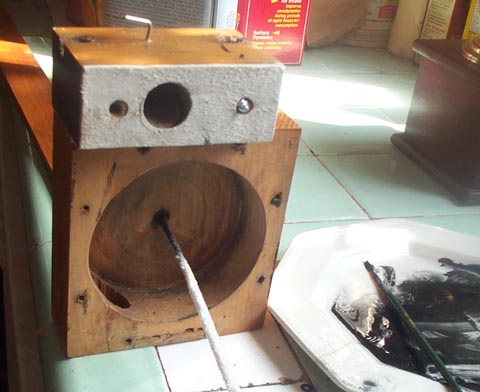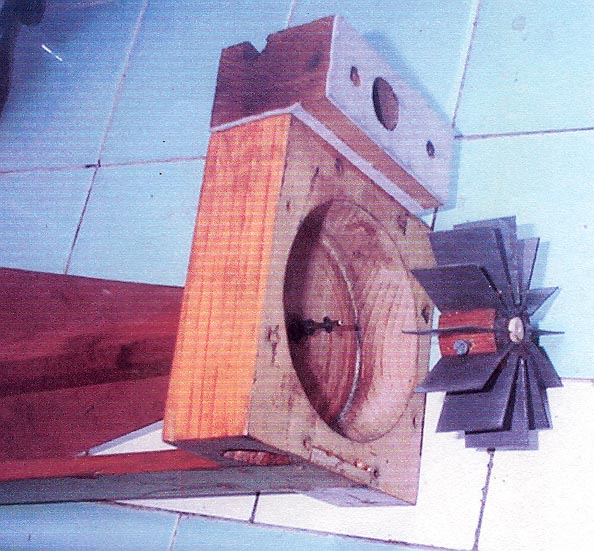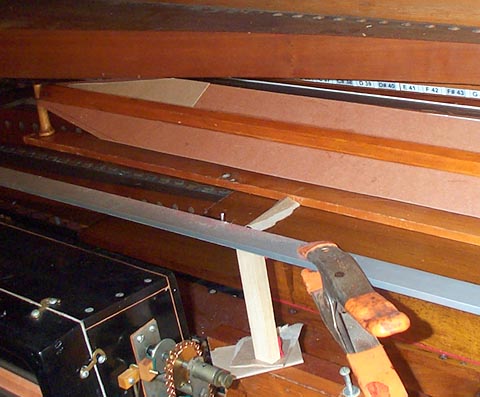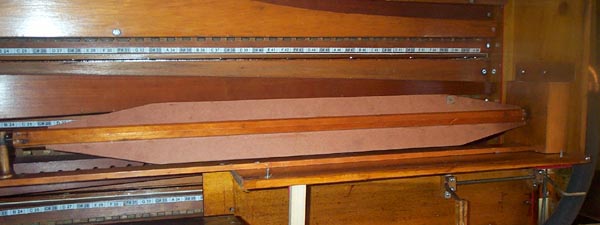

Chapter 23.3 Assembling and Testing the Vox Humana
After the paddle assembly and the turbine hub are finished, they are put together on the frame. First the bearing holes in the turbine and the support post at the other end, are lubricated with an alcohol soaked pipe cleaner, dipped in graphite. The next picture is not very good; the computer file got corrupted, so I had to scan the printed version. But the principle can be seen. The longer pin on the paddle shaft is inserted through the inner wall of the turbine case. The flat side of the turbine hub assembly is slipped over the pin. Number 4 fiber washers, the same as used on the key pivot screws (see Chapter 12.2) are used as bearing spacers on the pin. One washer (not shown) is put on the pin between the end of the paddle axle and the outside of the turbine case. Four of them are put on the pin, inside the turbine, to establish the space between the blades and the bottom of the turbine cavity.
Some care, and trial-and-error is required here. The hub must be located on the pin such that the turbine rotates more or less midway between the bottom of the cavity, and the inner surface of the turbine lid. The final position of the hub on the pin is somewhat critical. The horizontal slop of the assembled rotating parts must be large enough to prevent binding, but not so loose that the assembly could shift to the right, and allow the turbine to rub against the turbine lid. Originally, the hub was just force fitted on the pin, but this method will not hold reliably now. I put small set screws in the hub (one on each side, to preserve the balance), to cure this.


The assembled vox was installed in the organ swell box, and connected to wind for testing. When the divided floor of the swell box was propped up to its final level, a slight interference between the blades and the big Helmholz resonator was found. Using the blade template again, the blades were marked for further trimming.

Here is the completed vox humana, installed. The torque from the turbine is not really very great. To make the vox start reliably, and not stall or jerk, the rotating parts must be very well balanced around their center of rotation. In spite of all the care I took to make all the pieces symmetrical around the center, the balance was still imperfect. This was indicated by the fact that when the paddle was allowed to coast to a stop, it always ended up one way. By trial-and-error, a spot was found where a little washer, glued to one of the blades, corrected this. Now the system stops at any random rotary position.

After using the vox for a while, I decided to experiment. The vox still took an awful lot of wind. Of course many people have observed that the Orchestrelle vox humana does make for a lot more pumping effort, even in the best of situations. Like on any reed organ, this imposes a practical limit on its utilization. But still I wanted to see if it would work ok using somewhat less air flow. So I opened the gasketed joint between the distribution block and the turbine, and slid a piece of card into the joint, to act as an adjustable valve.
I discovered that I could reduce the flow a good deal, without slowing down the paddle rotation too much. This observation stands to reason. The torque produced in the turbine should be approximately proportional to the mass-flow of air through it. But the counter torque produced by the windage around the rotating paddle should be approximately proportional to at least the square of the rotational speed. In other words, doubling the air flow through the turbine would increase the paddle speed by only 141% or less. This partial "independence" between the torque and the speed, explains why the fan-fly governor in a music box works as well as it does, to hold the speed steady even as the spring winds down.
So I rigged a valve in the turbine outlet, as shown below.
Sure enough, I was able to reduce the wind usage
in the vox by quite a considerable amount, while still having an acceptable
tremolo rate. I found a good compromise speed by trying various valve
settings. The vane ended up rotating at about 157 RPM. Since
the paddle is symmetrical around its axis, its
reflective orientation switches twice for each rotation, producing
a pleasant trem rate of 5.25 Hz.